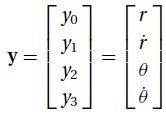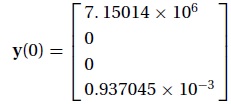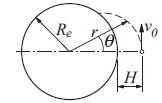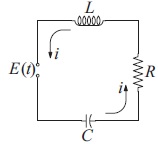


## module euler
''' X,Y = integrate(F,x,y,xStop,h).
Euler's method for solving the
initial value problem {y}' = {F(x,{y})}, where
{y} = {y[0],y[1],...y[n-1]}.
x,y = initial conditions
xStop = terminal value of x
h = increment of x used in integration
F = user-supplied function that returns the
array F(x,y) = {y'[0],y'[1],...,y'[n-1]}.
'''
import numpy as np
def integrate(F,x,y,xStop,h):
X = []
Y = []
X.append(x)
Y.append(y)
while x < xStop:
h = min(h,xStop - x)
y = y + h*F(x,y)
x = x + h
X.append(x)
Y.append(y)
return np.array(X),np.array(Y)
## module printSoln
''' printSoln(X,Y,freq).
Prints X and Y returned from the differential
equation solvers using printput frequency 'freq'.
freq = n prints every nth step.
freq = 0 prints initial and final values only.
'''
def printSoln(X,Y,freq):
def printHead(n):
print("\n x ",end=" ")
for i in range (n):
print(" y[",i,"] ",end=" ")
print()
def printLine(x,y,n):
print("{:13.4e}".format(x),end=" ")
for i in range (n):
print("{:13.4e}".format(y[i]),end=" ")
print()
m = len(Y)
try: n = len(Y[0])
except TypeError: n = 1
if freq == 0: freq = m
printHead(n)
for i in range(0,m,freq):
printLine(X[i],Y[i],n)
if i != m - 1: printLine(X[m - 1],Y[m - 1],n)
Integrate the initial value problem $$ {y}''=-0.1{y}'-x \:\:\:\:\:\:\: y(0)=0 \:\:\:\:\:\:\:{y}'(0)=1 $$ from x = 0 to 2 with Euler’s method using h = 0.05. Plot the computed y together with the analytical solution, \( y=100x-5x^{2}+990(e^{-0.1x}-1) \)
import numpy as np
from euler import *
import matplotlib.pyplot as plt
def F(x,y):
F = np.zeros(2)
F[0] = y[1]
F[1] = -0.1*y[1] - x
return F
x = 0.0 # Start of integration
xStop = 2.0 # End of integration
y = np.array([0.0, 1.0]) # Initial values of {y}
h = 0.05 # Step size
X,Y = integrate(F,x,y,xStop,h)
yExact = 100.0*X - 5.0*X**2 + 990.0*(np.exp(-0.1*X) - 1.0)
plt.plot(X,Y[:,0],'o',X,yExact,'-')
plt.grid(True)
plt.xlabel('x'); plt.ylabel('y')
plt.legend(('Numerical','Exact'),loc=0)
plt.show()
input("Press return to exit")
## module run_kut4
''' X,Y = integrate(F,x,y,xStop,h).
4th-order Runge-Kutta method for solving the
initial value problem {y}' = {F(x,{y})}, where
{y} = {y[0],y[1],...y[n-1]}.
x,y = initial conditions
xStop = terminal value of x
h = increment of x used in integration
F = user-supplied function that returns the
array F(x,y) = {y'[0],y'[1],...,y'[n-1]}.
'''
import numpy as np
def integrate(F,x,y,xStop,h):
def run_kut4(F,x,y,h):
K0 = h*F(x,y)
K1 = h*F(x + h/2.0, y + K0/2.0)
K2 = h*F(x + h/2.0, y + K1/2.0)
K3 = h*F(x + h, y + K2)
return (K0 + 2.0*K1 + 2.0*K2 + K3)/6.0
X = []
Y = []
X.append(x)
Y.append(y)
while x < xStop:
h = min(h,xStop - x)
y = y + run_kut4(F,x,y,h)
x = x + h
X.append(x)
Y.append(y)
return np.array(X),np.array(Y)
Integrate the initial value problem $$ {y}''=-0.1{y}'-x \:\:\:\:\:\:\: y(0)=0 \:\:\:\:\:\:\:{y}'(0)=1 $$ with the fourth-order Runge-Kutta method from x = 0 to 2 in increments of h = 0.2. Plot the computed y together with the analytical solution, \( y=100x-5x^{2}+990(e^{-0.1x}-1) \)
Solution: Letting y0 = y and y1 = y', the equivalent first-order equations are $$F(x,y)=\begin{bmatrix} {y}_{0}'\\ {y}_{1}' \end{bmatrix} = \begin{bmatrix} y_{1}\\ -0.1y_{1}-x \end{bmatrix}$$
import numpy as np
from printSoln import *
from run_kut4 import *
import matplotlib.pyplot as plt
def F(x,y):
F = np.zeros(2)
F[0] = y[1]
F[1] = -0.1*y[1] - x
return F
x = 0.0 # Start of integration
xStop = 2.0 # End of integration
y = np.array([0.0, 1.0]) # Initial values of {y}
h = 0.2 # Step size
X,Y = integrate(F,x,y,xStop,h)
yExact = 100.0*X - 5.0*X**2 + 990.0*(np.exp(-0.1*X) - 1.0)
plt.plot(X,Y[:,0],'o',X,yExact,'-')
plt.grid(True)
plt.xlabel('x'); plt.ylabel('y')
plt.legend(('Numerical','Exact'),loc=0)
plt.show()
input("Press return to exit"))
Use the fourth-order Runge-Kutta method to integrate $$ {y}'=3y-4e^{-x} \;\;\;\;\; y(0)=1 $$ from x = 0 to 10 in steps of h = 0.1. Compare the result with the analytical solution \( y=e^{-x} \)
## example7_5
import numpy as np
from run_kut4 import *
from printSoln import *
from math import exp
def F(x,y):
F = np.zeros(1)
F[0] = 3.0*y[0] - 4.0*exp(-x)
return F
x = 0.0 # Start of integration
xStop = 10.0 # End of integration
y = np.array([1.0]) # Initial values of {y}
h = 0.1 # Step size
freq = 20 # Printout frequency
X,Y = integrate(F,x,y,xStop,h)
printSoln(X,Y,freq)
input("\nPress return to exit")
Example7_6: A spacecraft is launched at the altitude H = 772 km above sea level with the speed v0 = 6700 m/s in the direction shown.

The differential equations describing the motion
of the spacecraft are
$$ \ddot{r}=r\dot{\theta }^{2}-\frac{GM_{e}}{r^{2}} \;\;\;\;\; \ddot{\theta }=-\frac{2{\dot{r}\dot{\theta }}}{r}$$
where r and θ are the polar coordinates of the spacecraft. The constants involved in
the motion are
G = 6.672 × 10−11 m3 kg−1s−2 = universal gravitational constant
Me = 5.9742 × 1024 kg = mass of the earth
Re = 6378.14 km = radius of the earth at sea level
(1) Derive the first-order differential equations and the initial conditions of the form
y' = F(t, y), y(0) = b.
(2) Use the fourth-order Runge-Kutta method to integrate the
equations from the time of launch until the spacecraft hits the earth. Determine θ at
the impact site
Solution:



## example7_6
import numpy as np
from run_kut4 import *
from printSoln import *
def F(x,y):
F = np.zeros(4)
F[0] = y[1]
F[1] = y[0]*(y[3]**2) - 3.9860e14/(y[0]**2)
F[2] = y[3]
F[3] = -2.0*y[1]*y[3]/y[0]
return F
x = 0.0
xStop = 1200.0
y = np.array([7.15014e6, 0.0, 0.0, 0.937045e-3])
h = 50.0
freq = 2
X,Y = integrate(F,x,y,xStop,h)
printSoln(X,Y,freq)
input("\nPress return to exit")
## module run_kut5
''' X,Y = integrate(F,x,y,xStop,h,tol=1.0e-6).
Adaptive Runge-Kutta method with Dormand-Price
coefficients for solving the
initial value problem {y}' = {F(x,{y})}, where
{y} = {y[0],y[1],...y[n-1]}.
x,y = initial conditions
xStop = terminal value of x
h = initial increment of x used in integration
tol = per-step error tolerance
F = user-supplied function that returns the
array F(x,y) = {y'[0],y'[1],...,y'[n-1]}.
'''
import math
import numpy as np
def integrate(F,x,y,xStop,h,tol=1.0e-6):
a1 = 0.2; a2 = 0.3; a3 = 0.8; a4 = 8/9; a5 = 1.0
a6 = 1.0
c0 = 35/384; c2 = 500/1113; c3 = 125/192
c4 = -2187/6784; c5 = 11/84
d0 = 5179/57600; d2 = 7571/16695; d3 = 393/640
d4 = -92097/339200; d5 = 187/2100; d6 = 1/40
b10 = 0.2
b20 = 0.075; b21 = 0.225
b30 = 44/45; b31 = -56/15; b32 = 32/9
b40 = 19372/6561; b41 = -25360/2187; b42 = 64448/6561
b43 = -212/729
b50 = 9017/3168; b51 =-355/33; b52 = 46732/5247
b53 = 49/176; b54 = -5103/18656
b60 = 35/384; b62 = 500/1113; b63 = 125/192;
b64 = -2187/6784; b65 = 11/84
X = []
Y = []
X.append(x)
Y.append(y)
stopper = 0 # Integration stopper(0 = off, 1 = on)
k0 = h*F(x,y)
for i in range(10000):
k1 = h*F(x + a1*h, y + b10*k0)
k2 = h*F(x + a2*h, y + b20*k0 + b21*k1)
k3 = h*F(x + a3*h, y + b30*k0 + b31*k1 + b32*k2)
k4 = h*F(x + a4*h, y + b40*k0 + b41*k1 + b42*k2 + b43*k3)
k5 = h*F(x + a5*h, y + b50*k0 + b51*k1 + b52*k2 + b53*k3 \
+ b54*k4)
k6 = h*F(x + a6*h, y + b60*k0 + b62*k2 + b63*k3 + b64*k4 \
+ b65*k5)
dy = c0*k0 + c2*k2 + c3*k3 + c4*k4 + c5*k5
E = (c0 - d0)*k0 + (c2 - d2)*k2 + (c3 - d3)*k3 \
+ (c4 - d4)*k4 + (c5 - d5)*k5 - d6*k6
e = math.sqrt(np.sum(E**2)/len(y))
hNext = 0.9*h*(tol/e)**0.2
# Accept integration step if error e is within tolerance
if e <= tol:
y = y + dy
x = x + h
X.append(x)
Y.append(y)
if stopper == 1: break # Reached end of x-range
if abs(hNext) > 10.0*abs(h): hNext = 10.0*h
# Check if next step is the last one; if so, adjust h
if (h > 0.0) == ((x + hNext) >= xStop):
hNext = xStop - x
stopper = 1
k0 = k6*hNext/h
else:
if abs(hNext) < 0.1*abs(h): hNext = 0.1*h
k0 = k0*hNext/h
h = hNext
return np.array(X),np.array(Y)
The aerodynamic drag force acting on a certain object in free fall can be approximated
by
\( F_{D}=av^{2}e^{-by} \)
where
v = velocity of the object in m/s
y = elevation of the object in meters
a = 7.45 kg/m
b = 10.53 × 10−5 m−1
The exponential term accounts for the change of air density with elevation. The differential
equation describing the fall is
where g = 9.806 65 m/s2 and m = 114 kg is the mass of the object. If the object is
released at an elevation of 9 km, determine its elevation and speed after a 10-s fall
with the adaptive Runge-Kutta method.
Solution:
## example7_8
import numpy as np
import math
from run_kut5 import *
from printSoln import *
def F(x,y):
F = np.zeros(2)
F[0] = y[1]
F[1] = -9.80665 + 65.351e-3 * y[1]**2 * math.exp(-10.53e-5*y[0])
return F
x = 0.0
xStop = 10.0
y = np.array([9000, 0.0])
h = 0.5
freq = 1
X,Y = integrate(F,x,y,xStop,h,1.0e-2)
printSoln(X,Y,freq)
input("\nPress return to exit")
Integrate the moderately stiff problem
y'' = −19/4y − 10y' y(0) = −9 y'(0) = 0
from x = 0 to 10 with the adaptive Runge-Kutta method and plot the results
Solution:
## example7_9
import numpy as np
import matplotlib.pyplot as plt
from run_kut5 import *
from printSoln import *
def F(x,y):
F = np.zeros(2)
F[0] = y[1]
F[1] = -4.75*y[0] - 10.0*y[1]
return F
x = 0.0
xStop = 10.0
y = np.array([-9.0, 0.0])
h = 0.1
freq = 4
X,Y = integrate(F,x,y,xStop,h)
printSoln(X,Y,freq)
plt.plot(X,Y[:,0],'o-',X,Y[:,1],'ˆ-')
plt.xlabel('x')
plt.legend(('y','dy/dx'),loc=0)
plt.grid(True)
plt.show()
input("\nPress return to exit")
## module midpoint
''' yStop = integrate (F,x,y,xStop,tol=1.0e-6)
Modified midpoint method for solving the
initial value problem y' = F(x,y}.
x,y = initial conditions
xStop = terminal value of x
yStop = y(xStop)
F = user-supplied function that returns the
array F(x,y) = {y'[0],y'[1],...,y'[n-1]}.
'''
import numpy as np
import math
def integrate(F,x,y,xStop,tol):
def midpoint(F,x,y,xStop,nSteps):
# Midpoint formulas
h = (xStop - x)/nSteps
y0 = y
y1 = y0 + h*F(x,y0)
for i in range(nSteps-1):
x = x + h
y2 = y0 + 2.0*h*F(x,y1)
y0 = y1
y1 = y2
return 0.5*(y1 + y0 + h*F(x,y2))
def richardson(r,k):
# Richardson's extrapolation
for j in range(k-1,0,-1):
const = (k/(k - 1.0))**(2.0*(k-j))
r[j] = (const*r[j+1] - r[j])/(const - 1.0)
return
kMax = 51
n = len(y)
r = np.zeros((kMax,n))
# Start with two integration steps
nSteps = 2
r[1] = midpoint(F,x,y,xStop,nSteps)
r_old = r[1].copy()
# Increase the number of integration points by 2
# and refine result by Richardson extrapolation
for k in range(2,kMax):
nSteps = 2*k
r[k] = midpoint(F,x,y,xStop,nSteps)
richardson(r,k)
# Compute RMS change in solution
e = math.sqrt(np.sum((r[1] - r_old)**2)/n)
# Check for convergence
if e < tol: return r[1]
r_old = r[1].copy()
print("Midpoint method did not converge")
## module bulStoer
''' X,Y = bulStoer(F,x,y,xStop,H,tol=1.0e-6).
Simplified Bulirsch-Stoer method for solving the
initial value problem {y}' = {F(x,{y})}, where
{y} = {y[0],y[1],...y[n-1]}.
x,y = initial conditions
xStop = terminal value of x
H = increment of x at which results are stored
F = user-supplied function that returns the
array F(x,y) = {y'[0],y'[1],...,y'[n-1]}.
'''
import numpy as np
from midpoint import *
def bulStoer(F,x,y,xStop,H,tol=1.0e-6):
X = []
Y = []
X.append(x)
Y.append(y)
while x < xStop:
H = min(H,xStop - x)
y = integrate(F,x,y,x + H,tol) # Midpoint method
x = x + H
X.append(x)
Y.append(y)
return np.array(X),np.array(Y)
The differential equations governing the loop current i and the charge q on the capacitor
of the electric circuit shown below are:
Ldi/dt+ Ri + q/C = E(t ) dq/dt= i
If the applied voltage E is suddenly increased from zero to 9 V, plot the resulting loop
current during the first 10 s.
Use R = 1.0 Ω, L = 2 H, and C = 0.45 F.
We solved the problem with the function bulStoer with the increment H = 0.25 s

Solution:
from bulStoer import *
import numpy as np
import matplotlib.pyplot as plt
def F(x,y):
F = np.zeros(2)
F[0] = y[1]
F[1] =(-y[1] - y[0]/0.45 + 9.0)/2.0
return F
H = 0.25
xStop = 10.0
x = 0.0
y = np.array([0.0, 0.0])
X,Y = bulStoer(F,x,y,xStop,H)
plt.plot(X,Y[:,1],'o-')
plt.xlabel('Time (s)')
plt.ylabel('Current (A)')
plt.grid(True)
plt.show()
input("\nPress return to exit")